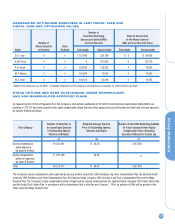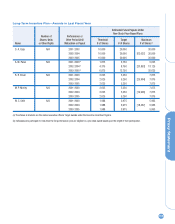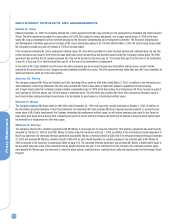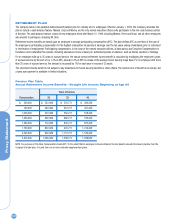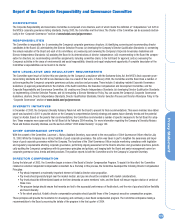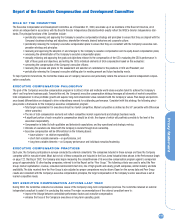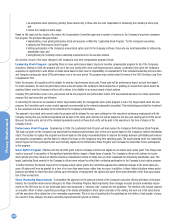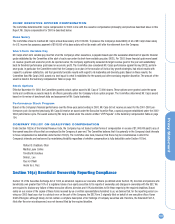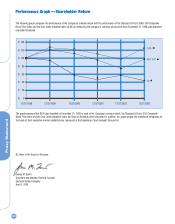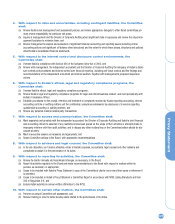Kodak 2003 Annual Report Download - page 117
Download and view the complete annual report
Please find page 117 of the 2003 Kodak annual report below. You can navigate through the pages in the report by either clicking on the pages listed below, or by using the keyword search tool below to find specific information within the annual report.
Proxy Statement
117
Report of the Executive Compensation and Development Committee
ROLE OF THE COMMITTEE
The Executive Compensation and Development Committee, as of December 31, 2003, was made up of six members of the Board of Directors, all of
whom are independent in accordance with the Board’s Director Independence Standards which exactly reflect the NYSE’s director independence stan-
dards. The principal functions of the Committee include:
• periodically reviewing and approving the Company’s executive compensation strategy and principles to ensure that they are aligned with the
Company’s business strategy and objectives, shareholder interests, desired behaviors and corporate culture;
• periodically reviewing the Company’s executive compensation plans to ensure that they are consistent with the Company’s executive com-
pensation strategy and principles;
• reviewing and approving the adoption of, and changes to, the Company’s executive compensation and its equity-based compensation plans;
• overseeing the administration of the Company’s executive compensation plans;
• annually reviewing and approving the goals and objectives relevant to the compensation of the CEO, evaluating the CEO’s performance in
light of these goals and objectives, and setting the CEO’s individual elements of total compensation based on this evaluation;
• overseeing the compensation of the Company’s executive officers;
• reviewing the process and plans for the assessment and selection of candidates for the positions of CEO and President; and
• periodically reviewing the Company’s executive staffing plan for meeting present and future leadership needs.
To help it perform its functions, the Committee makes use of Company resources and periodically retains the services of external independent compen-
sation consultants.
EXECUTIVE COMPENSATION PHILOSOPHY
The goal of the Company’s executive compensation program is to attract, retain and motivate world-class executive talent to achieve the Company’s
short- and long-term business goals. Towards this end, the Company’s executive compensation strategy leverages all elements of market-competitive
total compensation to drive profitable growth and superior long-term shareholder value consistent with the Company’s values. Plan design and perform-
ance-based differentiation are designed to drive extraordinary rewards for outstanding performance. Consistent with this strategy, the following princi-
ples provide a framework for the Company’s executive compensation program:
• Total target compensation for executives should be market competitive. Market competitive is defined as the 50th percentile with differences
where warranted.
• The mix of total compensation elements will reflect competitive market requirements and strategic business needs.
• A significant portion of each executive’s compensation should be at risk, the degree of which will positively correlate to the level of the
executive’s responsibility.
• Compensation is linked to both qualitative and behavioral expectations, and key operational and strategic metrics.
• Interests of executives are linked with the Company’s owners through stock ownership.
• Executive compensation will be differentiated on the following bases:
• base salaries—on relative responsibility,
• short-term variable elements—on performance, and
• long-term variable elements—on Company performance and individual execution/leadership.
EXECUTIVE COMPENSATION PRACTICES
Each year, the Company participates in surveys conducted by external consultants. The companies included in these surveys are those the Company
competes with for executive talent. Most, but not all, of these companies are included in the Dow Jones Industrial Index shown in the Performance Graph
on page 122. Starting in 2002, the Company also began measuring the competitiveness of its executive compensation program against a comparison
group of approximately 15 other leading companies, referred to in this Report as the “Peer Group.” The following criteria was used to select the Peer
Group: market capitalization, revenue, consumer/commercial/hi-tech mix, mix of high growth and steady growth companies, similar industry and data
availability. The data received from the Peer Group is size adjusted so proper comparisons may be drawn. Based on the survey data and Peer Group
results and consistent with the Company’s executive compensation principles, the target compensation of the Company’s senior executives is set at
market-competitive levels.
KEY EXECUTIVE COMPENSATION ACTIONS LAST YEAR
During 2003, the Committee conducted an extensive review of the Company’s long-term compensation practices. The Committee retained an external
independent consultant to assist it in conducting this review. The major recommendations of the external consultant were to:
• improve the linkage between controllable performance factors and executive compensation;
• enhance the focus of the Company’s executives on long-term operating goals;


